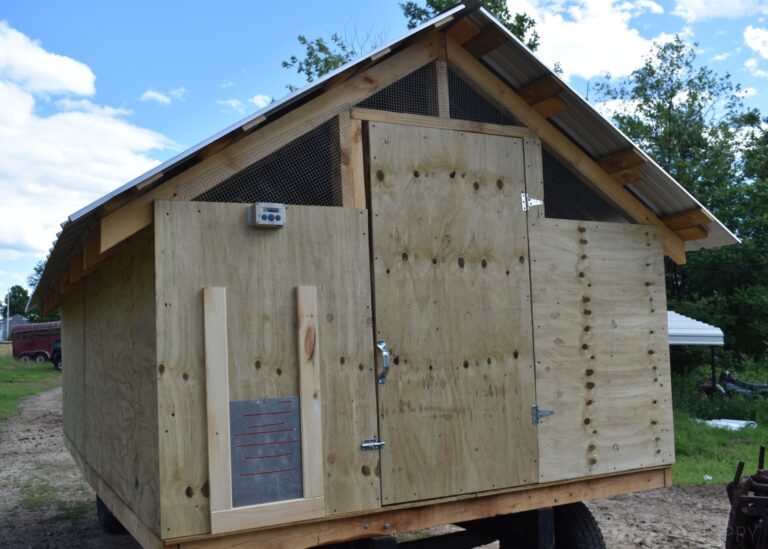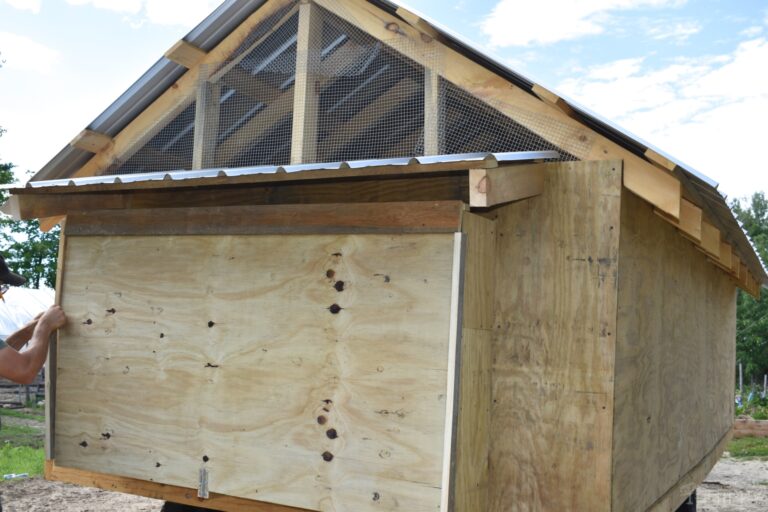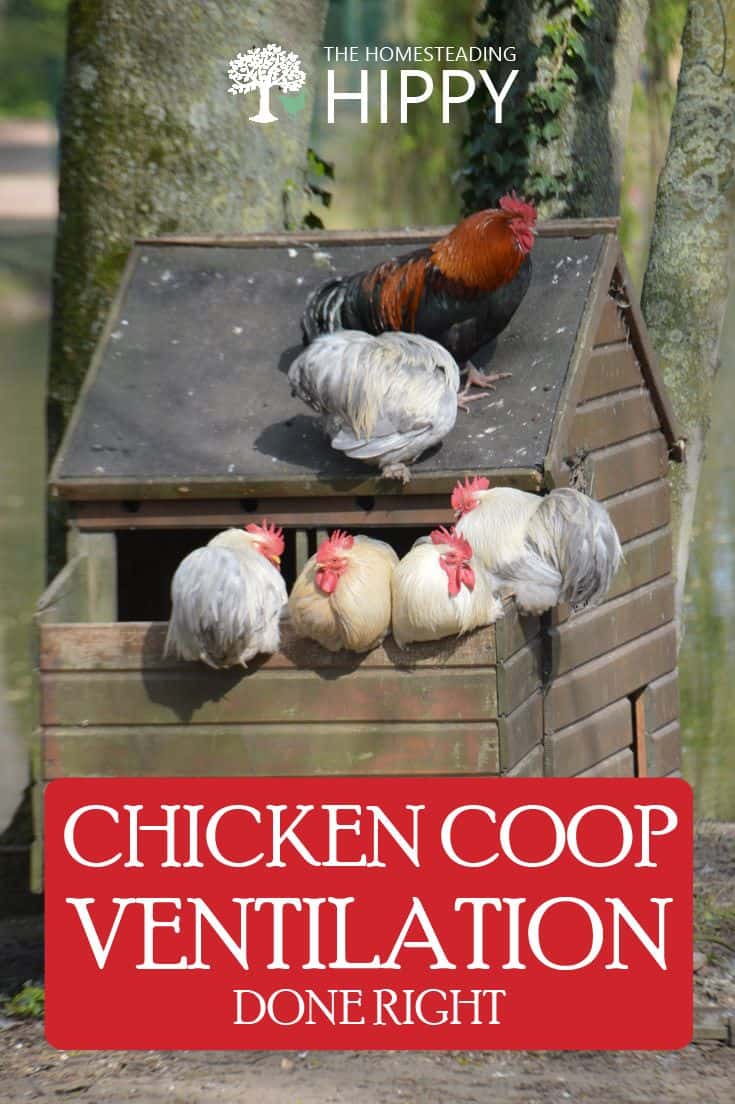When you’re building or buying a chicken coop, there are all kinds of features you’ll want to pay attention to.
How many nest boxes does it have? What about the roosting bars? Is it big enough for all of your chickens?

One feature that many people tend to overlook is how well the chicken coop is ventilated. If your chicken coop does not have enough ventilation, your chickens can suffer some pretty serious consequences, especially in wet weather and hot summer months.
Here are some tips for ventilating your chicken coop – as well as how you can get it done in a flash.
Table of Contents
Benefits of Chicken Coop Ventilation
There are several reasons to consider adding extra ventilation to your chicken coop.
One is that a well-ventilated coop can help remove dust, carbon dioxide, ammonia, excess humidity and dampness. Believe it or not, chickens actually generate a lot of water vapor when they breathe and poop.
Their poop contains all the water that they would normally urinate out, so it’s naturally a lot “wetter” than you might expect!
When a coop is moist and humid, the risk of your chickens developing frostbite or other problems in the wintertime occurs. If a coop is nice and dry during the winter, chickens can actually withstand a surprising level of frigidity.
And if you’re keeping other poultry species with your chickens – namely, ducks – you’re going to need to keep the coop even more well-ventilated, as ducks are wet little buggers!
While we’re on the subject of chicken poop, it’s important to realize that ventilating the coop properly also removes ammonia fumes. Unless you’re able to clean your chicken coop out literally every day, ammonia is going to build up over time.
Unfortunately, it doesn’t take all that much ammonia to harm the lungs of a chicken. Once the lungs are damaged – even marginally so – they are going to be much more vulnerable to various respiratory bugs. If you can smell ammonia in your coop, the levels are too high.
I already mentioned the humidity and ammonia issues. However, another issue is that a poorly ventilated coop will hold heat.
In the winter, that’s not a big deal (minus the frostbite issue I already told you about). However, in the summer, that’s a recipe for disaster, especially if you live in a warm climate.
Chickens are the healthiest when they are raised below 75 degrees Fahrenheit (23 Celsius).
Once the mercury rises above that – particularly over 90 degrees F (32 C) – your chickens are going to start suffering from severe health problems. They can undergo serious heat stress and if it gets too hot, they can even die.
This is especially true for chickens that are fuller-bodied or heavier-feathered. Ensuring proper ventilation will keep your chickens cool.
That’s not to say that you don’t need a well-ventilated coop in a cold environment, either! There might be some nights where a wicked snowstorm and a driving wind mean you close up some of the ventilation on your coop.
However, in most cases, you are going to want to keep things opened up even in the winter.
The Dangers of a Drafty Coop
There are lots of risks of having a drafty chicken coop. Many of these are just as bad – if not worse – than a coop that is not well-ventilated.
For starters, a drafty coop can cause your chickens to become cold even if the walls of the coop are well insulated, leading to illness, especially during the winter months. You’ll need to avoid drafts, especially those that are close to the roost.
A draft not only increases the likelihood that your chickens will become sick, but it increases the probability that your chickens will eat more.
While that doesn’t necessarily sound like a bad thing at first, remember that a hungry chicken eats more, and that can cut seriously into your food budget.
Plus, a coop that is drafty will have waterers that freeze more readily. You will also have frostbite to contend with.
How Much Ventilation Does Your Chicken Coop Need?
Unfortunately, your chicken coop probably needs more ventilation than you might think! You’ll need more ventilation in a coop than you do in almost any other kind of animal housing, in fact.
Integrate as much ventilation as you can afford and that your coop reasonably permits.
In most cases, as long as you don’t live in a super-warm climate, you can get away with one square foot of vent openings per chicken, or one square foot per ten square feet of floor area.
If you live in a warm climate, you may need to include more ventilation. The exception to this is if you live in a very dry area, because you won’t have to worry quite as much about moisture build-up.
You will also need to keep an eye out for overcrowding in the coop, as this can reduce your best efforts at ventilation and make them less effective.
What’s just as important when securing ventilation in your poop is making sure that drafts are eliminated.
While ventilation is essential, drafts are definitely not. Watch out for air gaps that will produce air leaks on the coldest days, which can cause condensation and frost.
The amount of ventilation you will need is also impacted by:
- The placement of your coop – a coop in hot, direct sunlight needs to be better ventilated
- How well-insulated the coop is
- What material your coop is made out of
How to Ensure Proper Ventilation In Your Coop
There are essentially three types of ventilation you can add to your coop.
The first is passive ventilation, or “natural” ventilation. With this method, you’ll have some openings in the coop that air flows through naturally. This could be as simple as some basic vent flaps, a louvered end vent, or even just an open window.
Passive ventilation methods will be the cheapest and easiest to integrate, but there are some risks. One of these is that predators will find it easier to get inside the coop.
Another type of ventilation is wind turbine ventilation. Yes, wind turbines – the ones you’re used to seeing out in open fields! You can add a wind turbine to the top of your coop and, as the wind blows, it will remove air from the coop.
The benefit of this system is that you don’t have to do much to keep your coop ventilation. It can be relatively tricky to install, though.
Add a Mechanical Fan
A final ventilation method is active or mechanical ventilation – in other words, a fan. Active ventilation will let you get greater air movement via smaller holes in the walls of the coop. You need to get a proper fan, though, or there are going to be some risks.
Adding a fan to the coop is pretty easy. Try to install two so that they can work together to push air out and in.
When you’re looking for a fan, be mindful of the fact that a household fan probably will not muster up.
Chicken coops are dusty and dirty, and they can easily break down – or worse, start a fire – in these dismal conditions. Instead, get a fan that’s rated to be used in a workshop or barn.
Use Metal Vents
Metal vents are often used in lieu of windows to add ventilation to the coop. They offer superior protection against the rain and snow, but don’t offer quite as much airflow. If you use metal vents to aerate your coop, you will need to use quite a few of them.
If you use vents, you will want to remember that warm air rises and cold air descends. You should place these vents on opposite walls or on every wall so that air can move through. They should be placed higher than the roost (but not directly above it).
You may also want to add a lower ventilation point if you live in a hot climate. This will allow cool air to enter form the bottom and warm air to exit out the top.
Make a Window
One of the easiest ways to ventilate your coop is to make a window – as long as you haven’t finished building your coop, that is. Even if you have, you can still use a saw to cut a window into your coop.
Either way, make sure your window is protected with hardware mesh to prevent predators.

Pop Doors
Pop doors are one of the most iconic, and also most useful, features of a chicken coop. A tiny, latching door on the side of the coop complete with a ramp that the chickens can take in and out is indelibly engraved in the minds of many as what a coop should look like.
But beyond the mundane utility of letting chickens enter and exit the coop, pop doors can also be used to improve ventilation when required. If you need to air out a smelly coop rapidly or just give the flocks and extra airflow on warm days you can leave the pop door open.
Pop doors are also compatible with automatic opening and closing systems, and sometimes can be purchased as a complete module or unit that is ready to install on an existing coop.
Compared to the full size door that you use to enter and exit the coop, the dangers associated with leaving a pop door open or much less.
Though they can still be caught by the wind or accidentally slammed on a bird that is standing or sitting in the door frame, it is far less likely to seriously injure the bird due to its much lighter weight.
Turtle Vents
Turtle vents are one or two piece square or rectangular components that are designed to be installed directly onto roofs after having a hole cut it them. These vent systems usually have openings on all sides to allow heat out or fresh air in.
Most also come with fine mesh or other screening material pre-installed to keep birds, insects and other unwanted wildlife from infiltrating your coop.
The best part about these events are that they are cost-effective, easy to install and usually too narrow or small gauge to prevent anything larger than rodents, snakes or insects from entering at all.
Birds of prey, foxes, raccoons and the like won’t be able to break in through a turtle vent unless the surrounding roof is damaged or they are improperly installed.
Depending on where you live, these entirely passive events may or may not be adequate to your ventilation needs, but they can work well for supplementary ventilation or just for improving airflow in conjunction with other systems, particularly active ventilation systems.
For pest proof installation on an existing coupe, a turtle vent or two might be just the ticket.
Cupolas
Cupolas are those raised, square structures you see adorning the tops of sharply peaked roofs. Decorative in nature, they also serve to help ventilate the structures they are attached to thanks to the louvers installed on each side.
Looking very much like a miniature church steeple, the charm of a cupola is undeniable, it looks great on a traditionally styled chicken coop that uses a pop door and ramp.
Cupolas do have a couple of unique advantages, however. Because it is a raised open space that protrudes even higher above the line of the roof, it provides more room for heat to rise up and escape compared to on- or in-roof ventilation systems.
For coops that are occupied near capacity or were designed anyway that makes them just a little bit too cramp and prone to staying humid, a cupola can alleviate the problem entirely and also greatly improve the appearance of your coop.
You can scratch-build a cupola using traditional framing techniques if you have knowledge of construction and roofing, or by ready-made kits that can be installed on most existing roofs.
Either way, these are a fantastic upgrade for a coupe and a good way to further improve ventilation, though they are one of the most expensive and labor intensive methods for doing so.
Turbines
Turbines, sometimes called whirligigs or whirlybirds, are those round, striated-fan looking things that you used to see regularly on the tops of residential roofs and some commercial buildings.
Turbines work very much like a fan to move air, but unlike powered fan systems these rely solely on wind and the temperature dynamics of the structure they are attached to to function.
Functioning very much like a propeller on an airplane or the screw on a ship, turbines push air in one direction, up and out.
As hot air rises from within the structure up to the ceiling and through the turbine, it will turn, aided by any wind outside. As it turns faster and faster it begins to draw hot air up, through it, and out, further increasing efficiency.
Some models are compact or low-profile in nature, and some are designed to be installed through the coop walls, drawing a breeze in one side and pushing it out the other.
The best part about turbines is that they are easy to install and surprisingly effective, particularly on large, wide roofs. However, they are typically a bit of an eyesore and do require periodic maintenance.
They can also be vulnerable to intrusion by smaller animals like snakes, rodents and insects, particularly when they are not spinning although clever modification using mesh can address this.
Tips for Adding Ventilation To Your Chicken Coop
When you are adding ventilation to the coop, make sure you think carefully about how many chickens you have, what kind of coop you have, and your climate.
Taking a few steps to keep the coop clean on a regular basis can reduce the overall efforts needed, too.
For instance, make sure the bedding doesn’t get wet by investing in high-quality, leak-proof chicken waterers. Clean out any soiled bedding on a regular basis or engage in the deep litter method to keep things dry.
Also, if you can, avoid housing chickens with other species of poultry, like ducks.
Remember that a new ventilation system in the coop doesn’t have to be permanent, either.
You can cover up certain ventilation systems when they aren’t in use. Invest in covers that are draft-proof, either because they fit snugly or because they have weatherstripping.
You can even bolt panels over ventilation systems (like windows) if you want to keep things sealed up when extra ventilation isn’t necessary.
In a warm climate, you will need large areas of ventilation that can be opened up on all four walls. You may want to build a coop with one removable wall entirely so that you can pull an entire wall off for additional ventilation in the summer.
Make sure all of your vents, regardless of where you live, are securely screened. Use a material like hardware cloth that will resist predators, even the stubborn ones, like raccoons.
Remember, you need to have some sort of screen that a predator can’t wiggle through or get its paws through to pull chickens out or against the wire.
When you’re adding ventilation, a good way to reduce air leaks is to put all of the ventilation up high – ideally above chicken level.
Do this at the tops of the walls so that everything is protected from rain, wind, and snow. This will protect the coop as it will be sheltered by the roof overhangs but also allow in fresh air.
You can add vent slots that are long and narrow, too. Avoid vents near the roost, especially if you live in a cold climate. You don’t want too much cold air blowing directly on your chickens.
Rather than covering the gables of your coop with wood, just cover them with hardware cloth or even though plastic. In most cases, you won’t have to worry about predators, but you’ll get cross-ventilation from moisture, hot air, and ammonia.
Should I Ventilate Near the Roost Bars or Bottom of the Coop?
You need to be careful about ventilation in your roost bars, which are generally anywhere from 12 to 48 inches higher than the floor.
There need to be minimal drafts near the roosting bars, especially if you live in an area that experiences a sub-zero winter.
At the bottom of the coop you’ll get some ventilation from your pop door and main door, your nesting boxes (if they open to the outside), and from drafts between your floorboards (although these should be reduced as much as possible).
When your pop door is closed, there shouldn’t be any drafts or air leaks around it. You don’t need to install screens or windows at the lower level of the coop, as there will be some natural gaps between your siding, nest box hatches, and any doors.
Any gaps down here should just be double-checked to make sure rats, snakes, and other small predators can’t slip in for an unwelcomed middle-of-the-night visit!
At the end of the day, ventilation is an important feature to have in any chicken coop. Even if you already have a coop, you can still add adequate ventilation. Just follow the tips mentioned above to create your own method of ventilation for happier, healthier chickens.


Rebekah is a full-time homesteader. On her 22 acres, she raises chickens, sheep, and bees, not to mention she grows a wide variety of veggies. She has a huge greenhouse and does lots of DIY projects with her husband in her ever-growing homesteading endeavor. Learn more about Rebekah here.

Excellent article thank you .